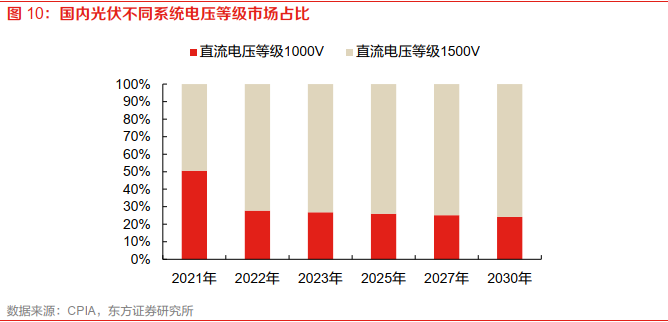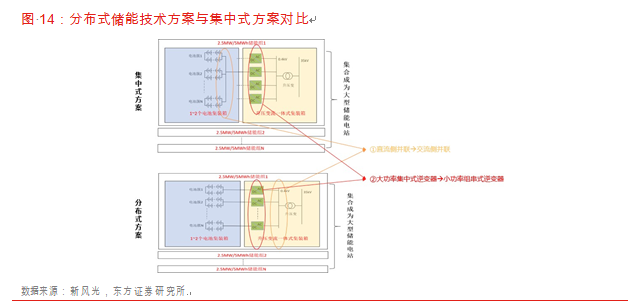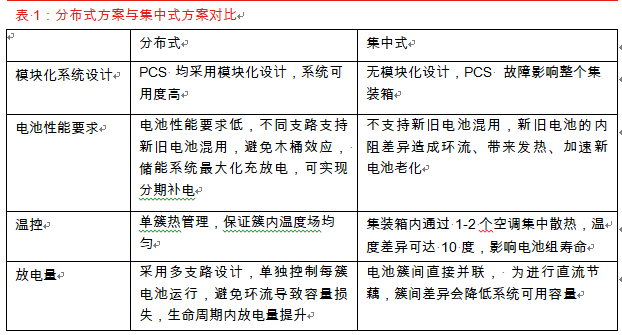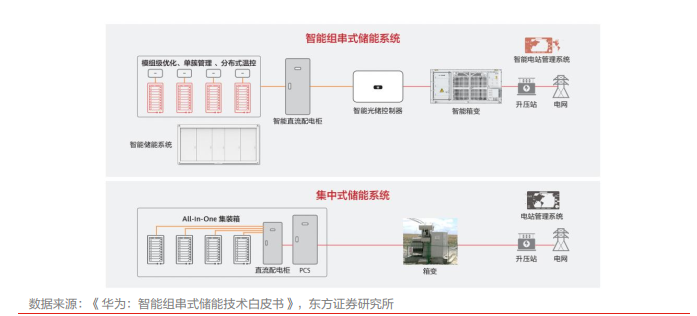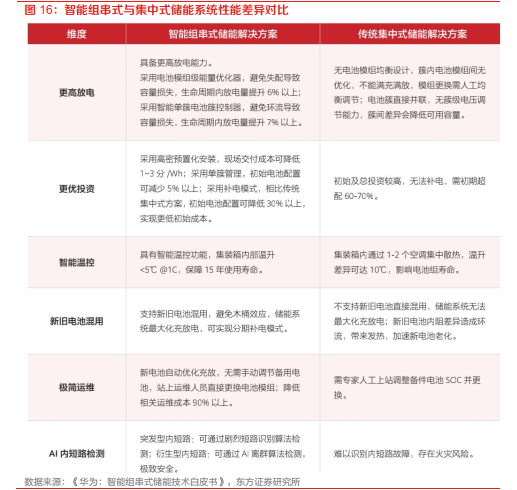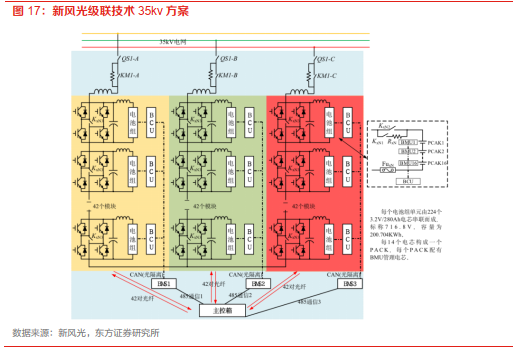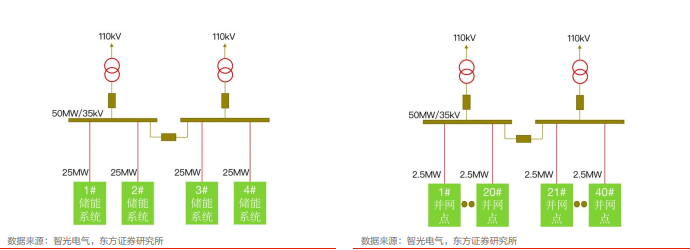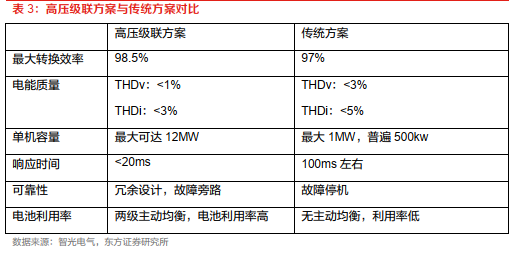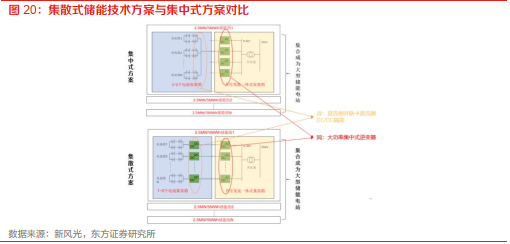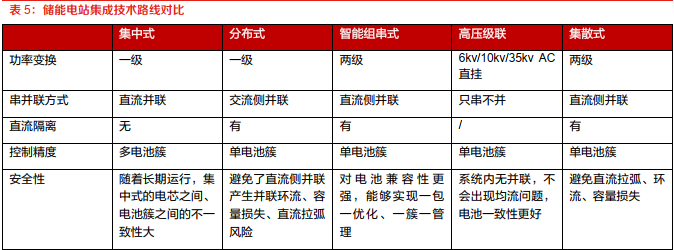| Five integrated technology trends of energy storage power stations |
| Release time:2023-01-30 10:07:37| Viewed: |
Five integrated technology trends of energy storage power stations
According to the electrical structure, the large energy storage system can be divided into:
(1) Centralized: low-voltage high-power booster centralized grid-connected energy storage system. The batteries are connected to PCS after multiple clusters are connected in parallel. PCS pursues high power and efficiency, and is currently promoting the 1500V scheme.
(2) Distributed: low-voltage low-power distributed boost grid-connected energy storage system, each cluster of batteries is linked to a PCS unit, and the PCS adopts low-power and distributed layout.
(3) Intelligent string type: based on the distributed energy storage system architecture, innovative technologies such as battery module level energy optimization, battery single cluster energy control, digital intelligent management, and fully modular design are adopted to achieve more efficient application of the energy storage system.
(4) High-voltage cascaded high-power energy storage system: the battery is inverted in a single cluster and directly connected to the power grid with voltage level above 6/10/35kv without transformer. The capacity of a single set can reach 5MW/10MWh.
(5) Distributed: DC side is connected in parallel with multiple branches, DC/DC converter is added at the outlet of the battery cluster to isolate the battery cluster, and DC/DC converter is connected to the centralized PCS DC side after collection.
一、Comparison of energy storage integration technology routes
Centralized scheme: 1500V replaces 1000V as the trend
With the development of centralized wind power plants and energy storage to larger capacity, DC high voltage has become the main technical scheme for cost reduction and efficiency increase, and the energy storage system with DC side voltage raised to 1500V has gradually become a trend.
Compared with the traditional 1000V system, the 1500V system increases the withstand voltage of cables, BMS hardware modules, PCS and other components from no more than 1000V to no more than 1500V.
The 1500V technical scheme of the energy storage system comes from the photovoltaic system. According to the statistics of CPIA, the market share of the domestic photovoltaic system with the DC voltage level of 1500V will be about 49.4% in 2021, and it is expected to gradually increase to nearly 80% in the future. The 1500V energy storage system will help improve the compatibility with the photovoltaic system.
Reviewing the development of photovoltaic system, the DC side voltage is 1500V. Through higher input and output voltage levels, the AC/DC side line loss and the loss of transformer low-voltage side winding can be reduced, and the efficiency of the power station system can be improved. The power density of equipment (inverter and transformer) is increased, the volume is reduced, and the workload of transportation, maintenance and other aspects is also reduced, which is conducive to reducing the system cost.
Taking the 1500V photovoltaic system solution released by TBEA in 2016 as an example, compared with the traditional 1000V system, the efficiency of the 1500V system is improved by at least 1.7%, the initial investment is reduced by 0.1438 yuan/W, the number of equipment is reduced by 30-50%, and the inspection time is reduced by 30%.
The performance of the 1500V energy storage system scheme is also improved compared with the 1000V scheme. Take the solar power supply scheme as an example. Compared with the 1000V system, the energy density and power density of the battery system have increased by more than 35%. There are fewer power stations with the same capacity. The cost of the battery system, PCS, BMS, cables and other equipment has been significantly reduced, and the cost of infrastructure and land investment has also decreased simultaneously.
It is estimated that compared with the traditional scheme, the initial investment cost of 1500V energy storage system alone has been reduced by more than 10%. But at the same time, the number of batteries in series increases after the voltage of 1500V energy storage system increases, and its consistency control becomes more difficult, and the requirements for DC arcing risk prevention protection and electrical insulation design are also higher.
Distributed scheme: high efficiency and mature scheme
The distributed scheme is also called AC side multi-branch parallel connection. Compared with the centralized technical scheme, the distributed scheme converts the DC side parallel connection of the battery cluster into the AC side parallel connection through the distributed series inverter, avoiding the parallel circulation, capacity loss and DC arcing risk caused by the DC side parallel connection, and improving the operation safety. At the same time, the control accuracy is changed from multiple battery clusters to a single battery cluster, and the control efficiency is higher.
Shandong Huaneng Huangtai Energy Storage Power Station is the world's first 100 megawatt distributed control energy storage power station. Huangtai Energy Storage Power Station uses the battery of Ningde era+the PCS system of Shangneng Electric. According to the calculation, after the energy storage power station is put into operation, the utilization rate of battery capacity of the whole station can reach about 92%, which is 7 percentage points higher than the current industry average level.
In addition, through the decentralized control of the battery cluster, the automatic calibration of the state of charge (SOC) of the battery can be realized, significantly reducing the workload of operation and maintenance. The efficiency of grid connection test is up to 87.8%. From the current project quotation, the cost of decentralized system is not higher than that of centralized system.
The distributed solution has the highest efficiency and limited cost increase. It is expected that its market share will gradually increase in the future. At present, the equipment of Ningde Times and Shangneng Electric Co., Ltd. is selected for the power station with 100 megawatts in operation.
Compared with the centralized scheme, the 630kw or 1.725MW centralized inverter needs to be replaced with a low-power series inverter. For the inverter manufacturer, if it has a series inverter product and has strong R&D capabilities, it can quickly cut into the distributed scheme.
Intelligent cluster scheme: one package one optimization, one cluster one management
The intelligent cluster scheme proposed by Huawei addresses three main problems in the centralized scheme:
(1) Capacity attenuation. In the traditional scheme, the use of battery has obvious "short board effect". The battery modules are connected in parallel. When charging, a single battery is fully charged, and charging stops. When discharging, a single battery is discharged, and discharging stops. The overall life of the system depends on the battery with the shortest life.
(2) Consistency. In the operation and application of the energy storage system, due to the different specific environment, there is a deviation in the battery consistency, resulting in the exponential decay of the system capacity.
(3) Capacity mismatch. Parallel connection of batteries is easy to cause capacity mismatch, and the actual use capacity of batteries is far lower than the standard capacity.
The intelligent cluster solution solves the above three problems of the centralized solution through the cluster, intelligent and modular design:
(1) String. The energy optimizer is used to realize the battery module level management, the battery cluster controller is used to realize the inter-cluster balance, and the distributed air conditioning reduces the temperature difference between clusters.
(2) Intelligent. AI, cloud BMS and other advanced ICT technologies are applied to the internal short circuit detection scenario, AI is applied to predict the battery state, and multi-model linkage intelligent temperature control strategy is adopted to ensure the optimal charging and discharging state.
(3) Modularization. The modular design of the battery system can separate the faulty module without affecting the normal operation of other modules in the cluster. With the modular design of PCS, when a single PCS fails, other PCSs can continue to work, and when multiple PCSs fail, the system can still operate.
High voltage cascade scheme: efficient scheme without parallel structure
The high-voltage cascade energy storage scheme is designed by power electronics to achieve 6-35kv grid-connected voltage without transformer.
Taking Xinfeng 35kv solution as an example, a single energy storage system is a 12.5MW/25MWh system. The electrical structure of the system is similar to that of high-voltage SVG, which is composed of A, B and C three-phase. Each phase contains 42 H-bridge power units and 42 battery clusters. There are 126 H-bridge power units and 126 battery clusters in total for three-phase, storing 25.288MWh of electricity. Each battery cluster consists of 224 cells in series.
The advantages of high-voltage cascade scheme are reflected in:
(1) Security. There are no parallel cells in the system, some batteries are damaged, the replacement range is narrow, the impact range is small, and the maintenance cost is low.
(2) Consistency. The battery packs are not directly connected, but are connected after AC/DC, so all battery packs can be controlled through AC/DC for SOC equalization. There is only a single battery cluster inside the battery pack, there is no parallel connection of battery clusters, and there is no current sharing problem.
In the battery cluster, the balance control between cells is realized through BMS. Therefore, this scheme can make the best use of the cell capacity. Under the condition of the same grid-connected power at the AC side, fewer cells can be installed to reduce the initial investment.
(3) High efficiency. Since the system operates in parallel without cells/battery clusters, there is no short board effect, and the system life is approximately equal to that of a single cell, which can maximize the operation economy of the energy storage device. The system does not need step-up transformer, and the actual system circulation efficiency on site reaches 90%.
As a new technical route, the high-voltage cascade scheme needs to be verified by operation:
On the other hand, the high-voltage cascade scheme is parallel connection at the AC side, multiple H-bridges are selected for connection, ABC three-phase AC, each phase has multiple H-bridges in series, and the reliability is reduced. In order to improve the reliability, redundancy design must be carried out. If one H-bridge fails, it can be switched to the bypass circuit.
(2) In terms of operation, the DC side and the AC side of the 35 kv energy storage system are placed in the same position, which increases the difficulty of operation and maintenance and poses certain safety risks. At present, the permeability of high-pressure cascade scheme is still low, and it needs to be verified by several projects for reliability and stability.
From the perspective of project price, the energy storage project price of high-voltage cascade scheme is similar to that of traditional projects. In April 2022, the bid price of CGN Hainan Baisha Bangxi 25MW/50MWh Energy Storage Project won by the consortium of Jinpan Technology and Tianjin Ruiyuan Electric Co., Ltd. was 64.99166 million yuan, with a unit price of 1.30 yuan/wh.
Distributed scheme: DC isolation+centralized inverter
The distributed scheme is also called the DC side multi-branch parallel connection. On the basis of the traditional centralized scheme, the DC/DC converter is added at the outlet of the battery cluster to isolate the battery cluster. The DC/DC converter is connected to the DC side of the centralized PCS after the collection, and 2-4 PCS are connected to a local transformer in parallel, and connected to the grid after the transformer is boosted.
By adding DC/DC isolation in the system, DC arcing, circulating current and capacity loss caused by DC parallel connection are avoided, which greatly improves the safety of the system and thus improves the efficiency of the system. However, the system needs to go through two-stage inverter, which has a negative impact on the system efficiency.
二、 Summary
Summary and comparison of five integrated technical routes for energy storage power stations
|



